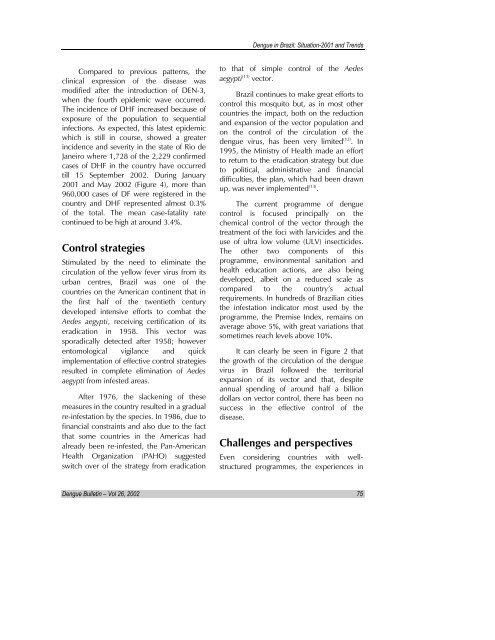Dengue Bulletin
Dengue Bulletin
Dengue Bulletin
- TAGS
- dengue
- bulletin
- 203.90.70.117
You also want an ePaper? Increase the reach of your titles
YUMPU automatically turns print PDFs into web optimized ePapers that Google loves.
Compared to previous patterns, the<br />
clinical expression of the disease was<br />
modified after the introduction of DEN-3,<br />
when the fourth epidemic wave occurred.<br />
The incidence of DHF increased because of<br />
exposure of the population to sequential<br />
infections. As expected, this latest epidemic<br />
which is still in course, showed a greater<br />
incidence and severity in the state of Rio de<br />
Janeiro where 1,728 of the 2,229 confirmed<br />
cases of DHF in the country have occurred<br />
till 15 September 2002. During January<br />
2001 and May 2002 (Figure 4), more than<br />
960,000 cases of DF were registered in the<br />
country and DHF represented almost 0.3%<br />
of the total. The mean case-fatality rate<br />
continued to be high at around 3.4%.<br />
Control strategies<br />
Stimulated by the need to eliminate the<br />
circulation of the yellow fever virus from its<br />
urban centres, Brazil was one of the<br />
countries on the American continent that in<br />
the first half of the twentieth century<br />
developed intensive efforts to combat the<br />
Aedes aegypti, receiving certification of its<br />
eradication in 1958. This vector was<br />
sporadically detected after 1958; however<br />
entomological vigilance and quick<br />
implementation of effective control strategies<br />
resulted in complete elimination of Aedes<br />
aegypti from infested areas.<br />
After 1976, the slackening of these<br />
measures in the country resulted in a gradual<br />
re-infestation by the species. In 1986, due to<br />
financial constraints and also due to the fact<br />
that some countries in the Americas had<br />
already been re-infested, the Pan-American<br />
Health Organization (PAHO) suggested<br />
switch over of the strategy from eradication<br />
<strong>Dengue</strong> in Brazil: Situation-2001 and Trends<br />
to that of simple control of the Aedes<br />
aegypti (11) vector.<br />
Brazil continues to make great efforts to<br />
control this mosquito but, as in most other<br />
countries the impact, both on the reduction<br />
and expansion of the vector population and<br />
on the control of the circulation of the<br />
dengue virus, has been very limited (12) . In<br />
1995, the Ministry of Health made an effort<br />
to return to the eradication strategy but due<br />
to political, administrative and financial<br />
difficulties, the plan, which had been drawn<br />
up, was never implemented (13) .<br />
The current programme of dengue<br />
control is focused principally on the<br />
chemical control of the vector through the<br />
treatment of the foci with larvicides and the<br />
use of ultra low volume (ULV) insecticides.<br />
The other two components of this<br />
programme, environmental sanitation and<br />
health education actions, are also being<br />
developed, albeit on a reduced scale as<br />
compared to the country’s actual<br />
requirements. In hundreds of Brazilian cities<br />
the infestation indicator most used by the<br />
programme, the Premise Index, remains on<br />
average above 5%, with great variations that<br />
sometimes reach levels above 10%.<br />
It can clearly be seen in Figure 2 that<br />
the growth of the circulation of the dengue<br />
virus in Brazil followed the territorial<br />
expansion of its vector and that, despite<br />
annual spending of around half a billion<br />
dollars on vector control, there has been no<br />
success in the effective control of the<br />
disease.<br />
Challenges and perspectives<br />
Even considering countries with wellstructured<br />
programmes, the experiences in<br />
<strong>Dengue</strong> <strong>Bulletin</strong> – Vol 26, 2002 75









